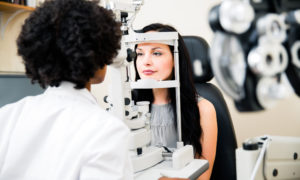Feb. 13, 2019

Eight in 10 employees are bothered by vision-related symptoms at work—ranging from eye fatigue and headaches (half of employees), to dry eyes and blurred vision (more than one in three employees), according to the 10th annual Transitions Optical Employee Perceptions of Vision Benefits survey.
The survey uncovered two factors specifically—digital eyestrain and light sensitivity—that have been linked with these symptoms and are contributing to further problems, such as lost productivity.
Six in 10 employees overall frequently experience digital eyestrain in the workplace. While a problem for all employees, it is more common among younger generations, who continue to make up a larger portion of today’s workforce. Millennials are the most likely to say they frequently experience digital eyestrain (seven in 10)—with one in five saying they experience it all the time at work.
Other Articles to Explore
Similarly, more than half of employees (54 percent) frequently experience light sensitivity in the workplace—with half (47 percent) also saying that light sensitivity negatively impacts their ability to do their job on a regular basis. Younger employees were more likely to say this as well—with one in five Gen Z and Millennial employees saying that they experience light sensitivity at work all the time, and an equal amount saying it negatively impacts their job performance.
When asked how light sensitivity and digital eyestrain affect them at work, employees said they are affected in many ways:
Four in 10 say they are less productive than they could be.
Three in 10 say light sensitivity and digital eyestrain make them unable to focus.
One in three takes more breaks throughout the day because of these factors.
While the vast majority of employees say they have taken steps to protect their eyes from light sensitivity and digital eyestrain at work—including dimming the brightness on their screen; limiting their screen time; and dimming lights in their workplace—the survey revealed that most employees are not taking advantage of simple solutions that are covered by many premium vision plans: wearing the right eyewear. Few employees reported taking steps, such as wearing lenses with anti-reflective or no-glare coatings (one in five employees overall), wearing photochromic or adaptive lenses (just over one in 10 employees overall) and wearing lenses with a blue light filter (one in 10 employees overall).
“Addressing digital eyestrain and light sensitivity in the workplace is becoming more important than ever for today’s employers—especially with research revealing that 44 percent of employees are more concerned about light sensitivity than they have been in previous years,” said Drew Smith, director, North America channels, Transitions Optical. “There are very simple steps employers can take to address these issues—with the most important one being to offer a vision benefits plan that covers eyewear options to alleviate these common visual problems, followed closely by ongoing education about the importance of sight-enhancing eyeglass lens options.”
Employees Want Premium Vision Benefits
When selecting eyewear, an overwhelming 94 percent of employees say that premium lens options are important to them—making vision plans that cover these a key differentiator for employers. The most desired premium lens options include:
Scratch-resistant lenses: 73 percent of employees
Anti-reflective or no-glare coatings: 71 percent of employees
Photochromic lenses, like Transitions Light Intelligent Lenses: 43 percent of employees
Blue light protection: 35 percent of employees
Employees showed a specific interest in vision plan coverage of photochromic lenses—which adapt their level of darkness and tint to enhance vision in changing lighting conditions. In fact, eight out of 10 employees said they would be more likely to enroll in or keep using a vision plan if it covered options like Transitions lenses. Furthermore, the survey uncovered that brand name does matter. More than six in 10 employees (64 percent) say it’s important that their vision plan covers authentic Transitions brand lenses, as opposed to other photochromic brands.
Transitions Optical offers a variety of employee- and employer-focused tools and education, free of charge, at HealthySightWorkingforYou.org.



























